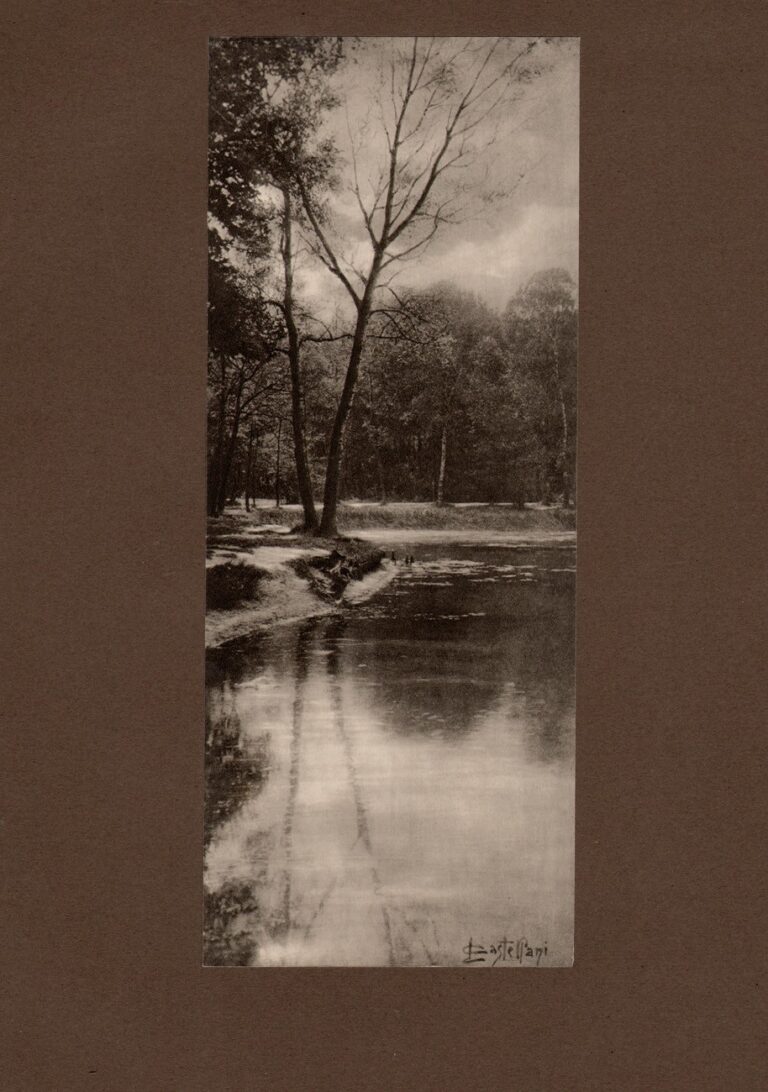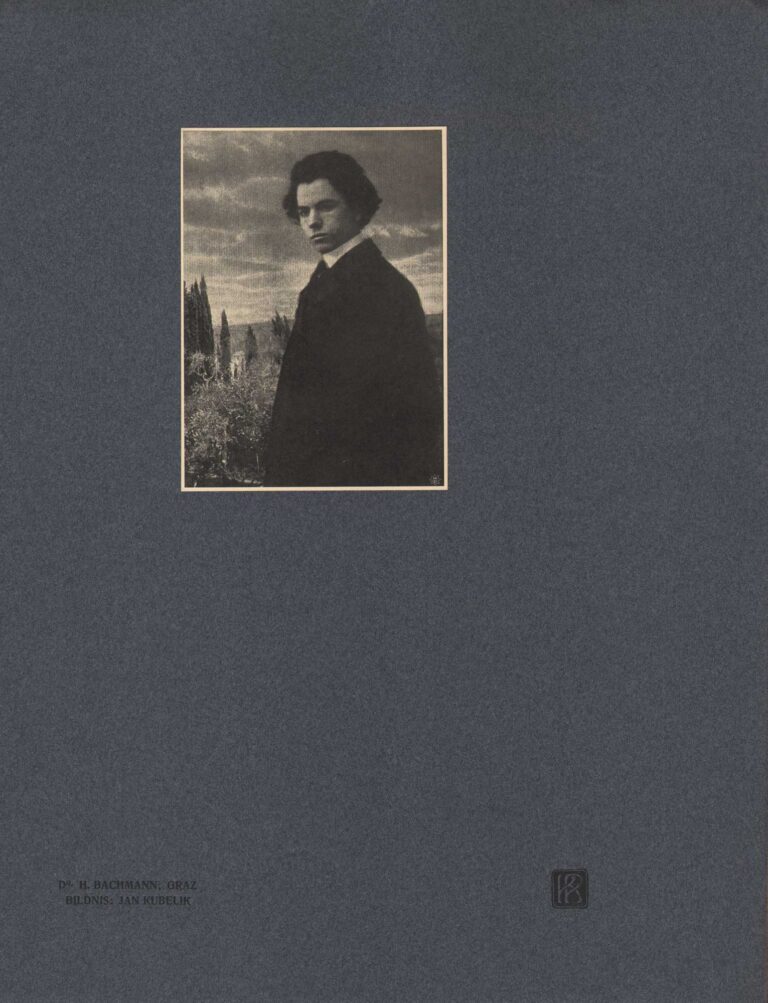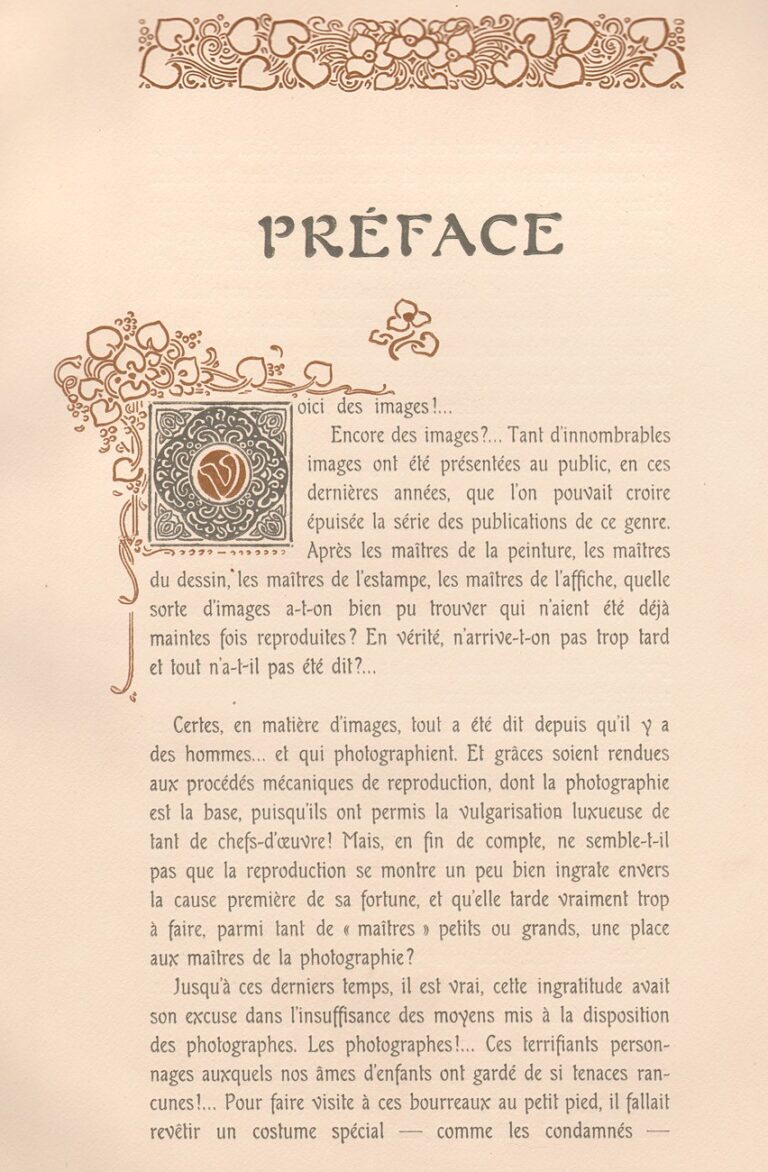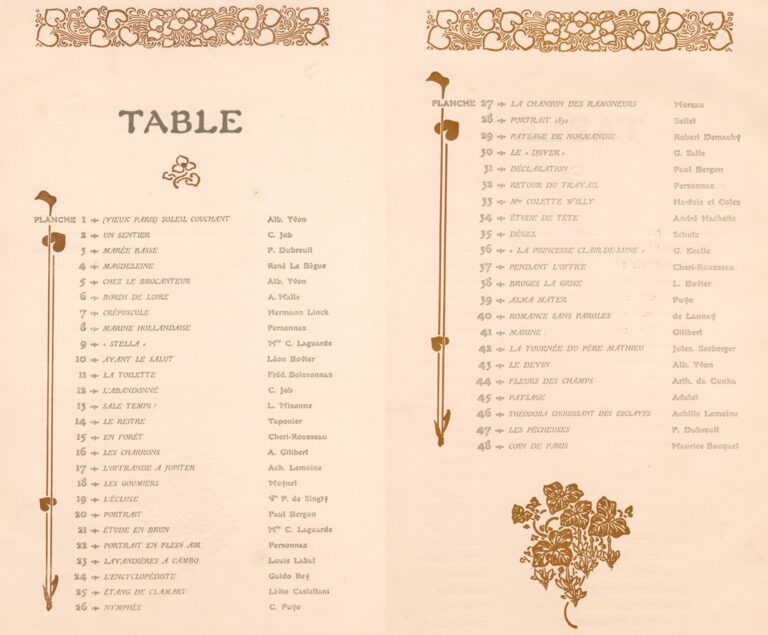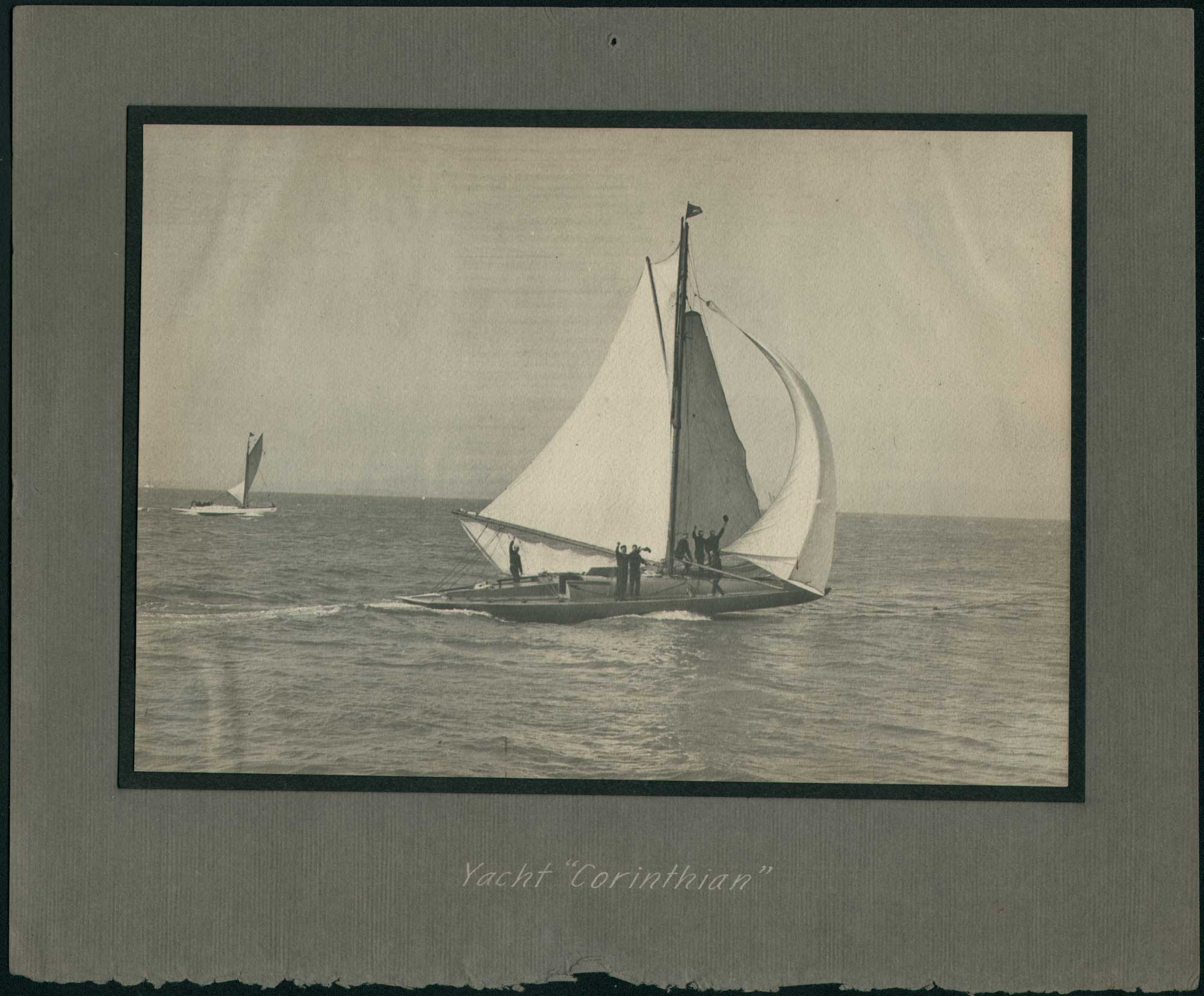
Yacht “Corinthian” Crossing Line a Winner
“The race on July 9, was the first that has ever taken place on the Bay of San Francisco between racing yachts of the most modern type.”
Based on a lengthy historical account in the magazine Western Field: The Sportsman’s Magazine of the West, this photograph shows the newly built racing yacht Corinthian crossing the finish line in 1904 in first place to defeat the 1902 sloop Challenger by 35 seconds. The entire article follows our biography and timeline for the photographer, H.S. Hoyt.
Herman Simeon Hoyt: 1868-1961
Born in Ohio, Herman S. Hoyt, a photographer who professionally went by H.S. Hoyt, lived in San Francisco, California as early as 1905 and was active there in the California Camera Club until at least the late 1920’s.
Timeline-Resources
1899: Living in Cincinnati, OH on Garfield Pl.- no occupation listed (Cincinnati-Hamilton County, Ohio city directory)
1899-1902: Actively photographs in Colorado. Two albums containing 92 photos from this period include his work and others now held at Yale University. Description: Photograph albums with photographs taken by H. S. Hoyt, Claire Lorimer Colburn, Walter W. Lewis, and Evan Lewis of Colorado scenes, 1899-1902. Depicted are Palmer Lake, Perry Park, the Colorado Springs & Cripple Creek District Railway, Colorado Springs, Garden of the Gods, lakes above Georgetown, and Denver (chiefly the city’s park and Valverde neighborhood). Included are photographs of unidentified Native American men, women, and children. Photographs attributed to Evan Lewis are of owls and ptarmigans, a gamebird in the grouse family. Images taken of Colburn, Hoyt, and Walter W. Lewis are identified in the album.
1902-1903: Southwest vernacular photograph album by Hoyt held at University of Utah – J. Willard Marriott Library. Description: “Vernacular” photograph album of Eunice L. Hunt of Lakeport, New Hampshire, containing images of travels throughout California, Arizona, and New Mexico. Photographs were likely taken by the professional photographer Herman Simeon Hoyt around 1902 or 1903 when Hoyt accompanied Professor William H. Dudley on a lecture tour of the Southwest. Titles and annotations are written on the page opposite of the corresponding photograph.
1902-03: Travels in the western United States. Album held by the University of California at Berkeley. Description: Herman S. Hoyt photograph album and diary pertaining to travels in Mexico, Arizona, New Mexico and California. Album of photographs made on travels chiefly in the American southwest and Mexico, together with typescript itineraries and travel notes made by Hoyt, who was a San Francisco resident, photographer, and member of the California Camera Club. These travels were undertaken on a lecture tour of Professor William H. Dudley of the Wisconsin State Normal School, from December 14, 1902 to April 2, 1903. Hoyt accompanied him and served as photographer and lantern slide operator as Dudley lectured on “Color in nature”. Views in the album include landscapes, architecture, Native Americans of the southwest, and Mexican people.
1902-61: Personal correspondence and last will of photographer from this time held at the University of California at Berkeley. Description: Herman S. Hoyt papers, 1902-1961. Personal correspondence, family history, and last will of Herman S. (Simeon) Hoyt, a photographer who lived and worked in San Francisco. The correspondence chiefly deals with the last wishes and disposition of his material goods and a list of people and family to contact upon his death, and an unsigned copy of his last will. Other correspondence includes letters to friends and a typewritten account of ” some vital statistics of the Hoyt family” written by Mr. Hoyt. Also includes sympathy floral cards, one from the California Camera Club, and a letter to the the County Clerk of San Francisco notifying them of the date and place of Mr. Hoyt’s death.
1903: Hoyt living at 1738 Champa St. in Denver, CO when he entered his photograph “Old Stairway-San Gabriel” (89) in the Third San Francisco Photographic Salon at the Mark Hopkins Institute of Art. Exhibition ran Oct. 8-24.
1905: January: in: Camera And Dark-Room: Hoyt mentioned as member of California Camera Club while exhibiting his work in the First Photographic Salon in America in New York City: “No. 150, by H. S. Hoyt of the California Camera Club, shows good work. He has called it ”Along the Dock.” The composition is satisfying, and the lights and shadows harmonious. The spars in the distance balance the picture admirably, and the sky and the water below are true both to nature and to art. This combination is not always attainable, but Mr. Hoyt, like the men of the Dutch school, has managed to secure it.” p. 10
1905 ca.: Photographs in Laguna Pueblo, New Mexico, with nearly 30 acetate photographic negatives now held in the Palace of the Governors Photo Archives, New Mexico History Museum, Santa Fe, New Mexico. Dates are conjectured to be roughly 1920-30, however a known Hoyt photograph from 1905: “Indian Pottery Burner” is a match with negative: “Woman burning pottery, Laguna Pueblo, New Mexico”
1905: In Camera Craft, the May issue mentions his works: “Along the Dock,” “San Francisco Bay,” “Indian Pottery Burner,” “Pueblo Indian Bake Oven.” p. 288
1906: The San Francisco Earthquake destroys the photographers home, including and all of his negatives and photo equipment. This photo shows the photographer sitting on the remains.
1907-1911: After the earthquake, Hoyt resurrected his commercial photography business by photographing signs and billboards. Work held at Bancroft Library at Berkeley: Description- Photographs of billboards ( by H.S. Hoyt) posted on walls around construction sites and lots in San Francisco during the years following the 1906 earthquake and fire. Billboards advertise San Francisco Examiner, Ridgway’s Tea, San Francisco Evening Globe, Morgan & Wright Tires, Hunter Whiskey, Kelleher & Browne tailors, Wicker & McManus, Centemeri Gloves, Kodak, and Luxus beer.
1909: Listed occupation is photographer, residing at 2239 Sutter St. in San Francisco (Crocker-Langley San Francisco directory, 1909)
1910: Strange Circumstances: Hoyt mentioned as being present at death of a fellow photographer. From the Mariposa Gazette (Mariposa, California) March 26: page 1, column 5. An Associated Press dispatch dated San Francisco, March 21, gives the following account of the death of Bruce M. Leitch of Wawona:
B. M. Leitch, artist, photographer and guardian of the [Mariposa] Big Trees at Wawona, died suddenly yesterday afternoon in the Palace hotel. The cause of death is not known exactly, as it came so suddenly that Dr. Julian Waller, who was summoned, was unable to determine the cause and refused to sign a certificate; so the body was turned over to Coroner Welch.
Leitch was apparently in good health at luncheon yesterday. He enjoyed his meal with Herman S. Hoyt of No. 2239 Sutter street, and then asked Hoyt to come to his room to look at some pictures. Just as Leitch had taken out the pictures and was decanting on their beauty, he put his hand to his throat, gasped for breath and fell dead on the floor.
Leitch was born in New York and came to California 26 years ago. He was interested in tree culture and undertook the post of guardian of the Big Trees, which position he has held since. He had a fine artistic sense and was known as a remarkably clever photographer. Some of his pictures are said to be the most artistic photographs of trees ever taken.”
1911: Listed as member of California Camera Club in Camera Craft, Volume 18.
– Two of his photographs: A Contra Costa Roadway, and The Road Along the Foothills used to accompany article: “Using A Soft Focus Lens” by C.A. Gwynn. pp. 271-75. (June: Camera Craft: A Photographic Monthly)
1912: Listed as Associate Editor for California Camera Club journal.
1913: Article in the Sausalito News on May 17: “Speaking of the coming outing, H.S. Hoyt, chairman of the Outing Committee of the Camera Club, said “An outing in Marin county is always looked forward to with the most pleasant anticipation by the members of our club. That particular section of the bay region offers more to the person who is hunting with the camera than any other locality. We expect that 100 people will make advent on that day with Lagunitas as the destination.“
1915: Photographs at the Panama Pacific International Exposition. Ferry Building illuminated (CHS2013.1269) at night and others are now part of the Herman S. Hoyt Collection at the California Historical Society, San Francisco.
1919: Secured copyright for map: “Mariposa grove of big trees.” April 3, 1919 and April 14, 1919.
1920: US Census: living at 2527 Sutter St. in San Francisco. Occupation is photographer.
1926: Still active in the California Camera Club. “After the Day’s Hunt”, “The Road Home” and “Peacock Lane” are some of his exhibited works listed in the Members Exhibit with some published in the journal: The Camera: The Photographic Journal of America, Vol. 33.
1930: US Census: living at 1609 Clay St. in San Francisco. Now 62 years of age, his occupation is now salesman at a curio shop.
1961: September 21. Death, buried at Cypress Lawn Memorial Park- Colma: San Mateo County, CA. A photograph of the Hoyt as a younger man has been posted here.
2013: Unknown auction house sells rare albums featuring work of H.S. Hoyt and others, with the first two of these albums ca. 1899-1902 now at Yale. (see above timeline) Auction house description: IMPORTANT LOT OF PHOTOGRAPHY ALBUMS DONE BY PHOTOGRAPHERS “H.S. Hoyt”, “C.L. Colburn”,” W.W. Lewis” and “Evin Lewis”(sic) – Colorado Pictures circa 1899-1902 album # 1 features a Picture of H.S.Hoyt sitting on a Burrow, also features C.S. & C.C.D. Railroad, The Depot at Palmer Lake Colorado, Perry Park around 1900 of Vincents House”, a picture of W.W.Lewis on Rock at Perry Park, Palmer Lake,Colorado Springs & Cripple Creek District Railroad, Locomotive at Pike’s Peak Cog Road (total of 6 train related photo’s), Cripple Creak, several photo’s of “City Park Denver”, Photo of “Indian Brave”, “Indian Camp City Park Denver, (2) photo’s of “Indian Family”, Platte River Bridge with Loretto Academy on Hill, (4) photo’s of Lakes above Georgetown photo’s by Lewis, “Near Colorado Springs” and “High School Cadet Camp-Co.Springs” photo’s by Colburn, Ptarmigans nests by Lewis, and end of book # 1 photo “Longfellow School Football Team Early 1890’s picturing “billy Meek, Geo. Steck, Rueben Taylor, Ev. Owens, Frank Lewis, and Joe Lambert and single photo of “Ralph McCormack M.T.H.S.- Photo Album # 2 same years 1899-1902 includes photo’s Denver in Winter, Photo of “Thad Sowder on his horse, People on Horse’s watching the Race, “Near Valverde”, “Indian Family”,”Colburn, Hoyt, and Lewis in log cabin opening to “Mine of Colorado School of Mines showing “Clare Colburn, Walter Lewis & Larson, “The Vincent Children on burro, Walter Lewis on burro, “Broadmoor Colorado Springs”, Trail near Manitou, Garden of Gods, “Surveying for the Telephone Line Southwestern Colorado”, J.F.Lambert Head, Silver Pick Mill-F E Lewis, Young boy leading team of Oxen New Mexico, Young Owls taken by E.Lewis, “San Francisco Harbor photo by Hoyt, Photo Album book # 3 circa 1910- Titled “Western Trips 1910 W.W.Lewis (most of this book features construction and locations of Power plants and power lines,) and other power plants-COLORADO- San Francisco, Utah, and Tahoe. THESE THREE PHOTO ALBUMS WILL BE SOLD AS ONE LOT!! A WONDERFUL SCENIC AND HISTORIC WALK BACK IN TIME!
The following article on the yacht race referenced at the top of this post provides detailed historical and technical details of modern racing yachts in the Bay of San Francisco in 1904, and hence a fascinating look at the willingness to spend large sums of money in designing racing yachts that have evolved to our present 124 years later. (2024- apologies ahead for any transcription errors)
RACE FOR THE PERPETUAL CHALLENGE CUP, 1904.
By ARTHUR INKERSLEY.
IN 1902 the San Francisco Yacht Club, with the newly built sloop Challenger, designed by B. B. Crowninshield of Boston, and sailed by W. G. Morrow, won the Perpetual Challenge Cup-the blue ribbon of San Francisco Bay yachtsmen. The Corinthian Yacht Club’s representative, Sharpe & Toepke’s sloop Harpoon, sailed by her designer and builder, F. R. Cooke, was beaten by a margin of 10 minutes 54 seconds, corrected time. The sloop Challenger is a fin-keel boat, 42 feet 6 inches over all, 26 feet 15 inches on the water line, 10 feet 4 inches extreme beam, 2 feet 6 inches draft of hull, and 6 feet 6 inches extreme draft. At first the mainsail contained 800 square feet of canvas, and the jib 206 square feet, a total of more than 1,000 square feet; but this area was reduced to 964.26 square feet. Her racing length is 28.60.
The Corinthians might have regained possession of the cup by challenging in the 36-foot or 41-foot class, in which the San Francisco Yacht Club has no fast boats; but, having lost the trophy in the 30-foot class, they determined to try to win it back in that class. Believing the Challenger to be as fast a boat of the fin-keel type as they could reasonably expect to get, they thought that their best chance of victory Lay in building a boat of a wholly different type. Accordingly last year ex-Commodore John W. Pew, on behalf of the Corinthian Yacht Club, procured from Burgess & Packard, the well known ship designers of Boston, plans for a vessel of the extremely shallow, scow type, fitted with a centerboard. The measurements are as follows: Length over all, 56 feet; length on the water line, 24 feet; beam, 14 feet 6 inches; draft, 2 feet 6 inches, and centerboard with a drop of about 8 feet. A strike among the steel workers in Massachusetts caused great delay in the shipment of the steel truss which is an essential feature of the construction of the boat, and prevented the completion of the yacht at a date early enough to admit of a challenge for the cup being sent in during 1903.
On April 2, 1904, the new sloop was launched from F. Stone & Co.’s shipyard on North Beach, and was named “Corinthian. She was under sail next day, and, as soon as the Corinthians had satisfied themselves of her capability a challenge was sent in to and accepted by the San Francisco Yacht Club, which named the Challenger, now the private property of W. G. Morrow, as defender of the trophy. By agreement between the regatta committees of the two clubs, the race was set for Saturday, July 11. The steamer Resolute, which carried the referee, Allen M. Clay, and the regatta committees, was crowded with yachting enthusiasts, who generally agreed that the management of the race was all that could be desired. The representatives of the San Francisco Yacht Club were Dr. T. L. Hill (vice ex-Commodore R. S. Bridgman, one of the crew of the Challenger), Roy C. Ward and C. M. Gunn. The Corinthian representatives were T. J. Kavanagh, James K. Bulger and ex Commodore A. J. Young (vice Douglas Erskine, one of the Corinthian’s crew). The course was that of the challenged party, the San Francisco Yacht Club. The starting line was a few hundred feet off the north end of Powell street wharf, and was marked by the launch Rob Roy at one end and a whitehall boat at the other. After crossing the starting line the yachts proceeded on a broad reach three miles due north to and around a stakeboat anchored off Quarry Cove, Angel Island; thence beat out to Presidio Shoal Buoy; around it, and before the wind to the leeward stakeboat, anchored over the site of Blossom Rock; around it and out to Presidio Shoal Buoy a second time; around it and back to the finishing line between the judges’ steamer tied up to Powell street wharf and the whitehall before mentioned.
The race was sailed almost wholly on an ebb tide, it being low water at 1:52 P. M. at Fort Point. The preparatory whistle was sounded from the judges’ steamer at 12:25 P. M., and the starting whistle at 12:30 P. M. The Challenger, smart and trim, with freshly painted white hull, and the Corinthian, with blackleaded body, had been cruising to and from for nearly an hour, waiting for the preparatory signal. The Challenger was steered by W. G. Morrow, commodore of the San Francisco Yacht Club, his crew being made up of ex-Commodore R. S. Bridgman and J. C. Cockerill (both of whom sailed on the Challenger in the winning race of 1902), Harry Helen, Hillyer Deuprey, W. W. Farrar and W. W. Haley. The Corinthian was steered by Frank Stone, his crew being Commodore T. Jennings, Vice-Commodore J. C. Brickell, Douglas Erskine, Neill McLear, J. Short and F. E. Schober.
The Corinthian crossed the line at 12:31:14 P. M., being followed at 12:31:49 P. M. by the Challenger, 35 seconds later. The yachts being allowed two minutes within which to cross the line, neither gained or lost anything on the start. The Corinthian rounded the northerly stakeboat off Angel Island at 12:52:43 P. M.. and the Challenger at 12:54:25 P. M., the Corinthian having gained 1 minute 7 seconds on the leg. On the beat out to Presidio Shoal Buoy the Corinthian gained 42 seconds more, rounding the mark at 1:41:28 P. M., the Challenger rounding at 1:43:52 P. M. The Corinthian’s total gain on the first two legs was 1:49. On the run from Presidio Shoal Buoy to the stakeboat on the site of Blossom Rock the Challenger was some what slow in getting her light sails up. The reckoning time allowance, having a lead of 22 Corinthian rounded the mark at 2:05:58 P. M., seconds at this point of the race. On the run and Challenger at 2:09:01 P. M., Corinthian gaining 39 seconds on the leg.
The Corinthian’s total gain was now 2 minutes 28 seconds, or 24 seconds more than enough to eat up the Challenger’s time allowance of 2 minutes 4 seconds. On the second beat out from Blossom Rock to Presidio Shoal Buoy the wind had freshened a little and the water was somewhat rougher. The Corinthian rounded the mark at 2:38:31 P. M.. and the Challenger at 2:40:48 P.M., the Challenger gaining 46 seconds on this leg, and, reckoning time allowance, having a lead of 22 seconds at this point of the race. On the run home, however. the Corinthian gained 1 minute 3 seconds. thus beating the Challenger by the narrow margin of 41 seconds.
The racing length of the winner was given at 29.91 feet in the letter of challenge, and the time allowance given to the Challenger was calculated on this measurement.
The times taken by the two yachts to cover each leg of the course are shown comparatively in the table: (timing chart omitted from this transcription)
Though the Corinthian Club well deserved its victory for its spirit in building the challenging yacht, the margin by which she won was so small that the Challenger, on a second meeting, might turn the tables. It is thought by many of the admirers of the Challenger that a heavier wed and rougher sen would have suited her much better than the moderate breeze and smooth water prevailing on July 9. There are also yachtsmen who think that the Challenger might have covered the course in shorter time than she did even under the conditions of weather that she encountered.
It is said that the light sails were not handled as smartly as Shoal Buoy the Challenger gained 46 seconds on the Corinthian shows that different conditions would be very likely to produce a different result. It is not likely that either the San Francisco or Corinthian Yacht Club would incur the heavy expense of building other racing boats for some years to come, so that. unless the California. Vallejo or South Bay Club comes forward with a challenge, contests between the Corinthian and the Challenger may be expected to occur annually. The boats are closely enough matched to render several such struggles Interesting.
Though It is not probable that any private they might have been, and that the Challenger is quite capable of beating the Corinthian.
Whatever may be the merit of these criticisms, it is certain that 41 seconds is by no means a decisive beating, especially under conditions regarded as particularly favorable to the beamy, shallow boat. It is practically certain that the Challenger will come out next year as the representative of the San Francisco Yacht Club in the annual race for the Perpetual challenge Cup and that the Corinthian will be the defender of the trophy. So another battle royal between the two fastest craft on the bay of San Francisco is almost certain to occur, and is already being looked forward to by yachtsmen. The fact that on the beat out from Blossom Rock to Presidio owner or ever any club on the bay will want to build another craft of the Corinthian type, she has served to kindle a great interest in yachting and to keep alive the game of yacht-racing in this part of the world. The Corinthian is an ugly, uncomfortable craft, whose sole end is racing. She has no cockpit and no cabin; the crew can neither stay on deck nor go below. The steersman sits upon a little box placed aft and the crew hang on wherever they can. Though she handles wonderfully and makes great speed, reaching or running, with hardly any fuss in smooth water, she is hardly equal to the Challenger in a hard beat. I do not know whether she pulled her centerboard up when running before the wind or not: but it is to be supposed that she did. According to the racing rule prevalent off the coasts of Great Britain. she would have been compelled to keep her centerboard down all the time: in fact, the centerboard would have been dropped and sealed by one of the committee-men before the start of the race.
The idea of British yachtsmen is that, as a keelboat can not pull her keel up when running before the wind, the centerboard craft should not be permitted to pull her board up in order to diminish the friction of her hull against the water, the race on July 9, was the nrst (nearest) that has ever taken place on the Bay of San Francisco between racing yachts of the most modern type. Of the other yachts that have taken part in races for the San Francisco Perpetual Challenge Cup, the Queen is a centerboard boat of the regular cruising type, while El Sueso, Catharine, Fawn and Truant are cruising boats that were reconstructed with the view of increasing their speed and lessening their measurements. Aeolus, Presto and Harpoon were built for fast cruising, with an eye to winning races. Helen and Gadder Were built for speed and have little cabin accommodation. Of all these, the Aeolus, owned by Carl Westerfeld and R. H. Morrow was the most successful. capturing three Macdonough trophies, each worth $250.00, and winning the Perpetual Challenge Cup twice, in 1897 and 1900. She has also won cups in the Pacific Inter-Club Yacht Association’s races and in other events.
Though Aeolus, Presto, Harpoon, Helen and Gadder are used regularly for pleasure sailing, the comfort of those on board is subordinated to the main consideration of speed. The Challenger was built to win the Perpetual Cup and was the first example of a regular racing yacht on the Bay of San Francisco. Yet she cruises up to Vallejo, Napa City, the Sacramento river, her crew living and sleeping on board. The Corinthian is a mere racing machine, good for no other purpose whatever. She was built to win the Perpetual Cup back from San Francisco Yacht Club and her main end was fulfilled when she did this.
Racing yachts of the scow type are much used in Eastern waters, but are not likely to become numerous here. By excellent workmanship, Frank Stone, the builder of the Corinthian, succeeded in making her watertight, but boats of this type, owing to their extreme shallowness and flat floors, are almost always leaky. They are eminently unsuitable for cruising, which is the main end and purpose of the San Francisco Bay yacht. If such boats do go on a cruise, they must be accompanied by other yachts, on which their crews may get their food and sleep. – Western Field: The Sportsman’s Magazine of the West: August, 1904: pp 55-58
